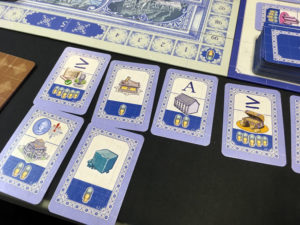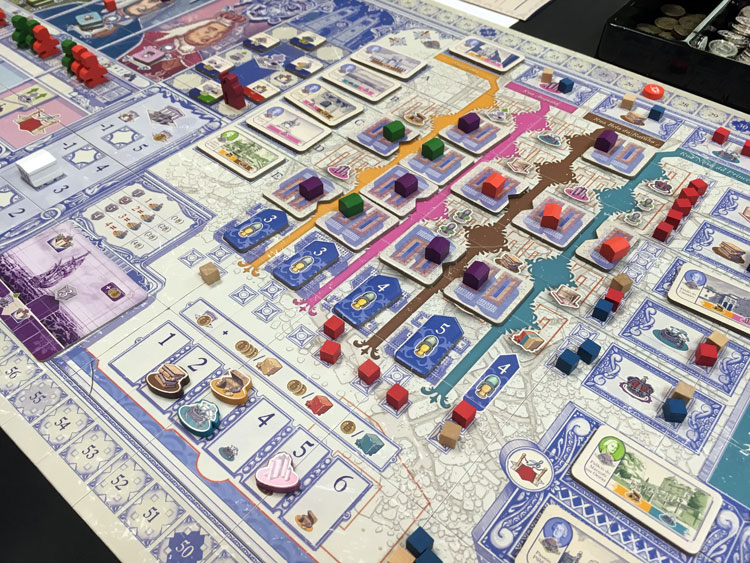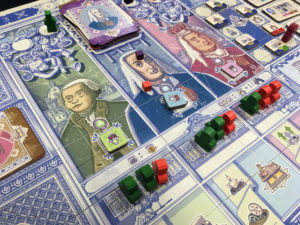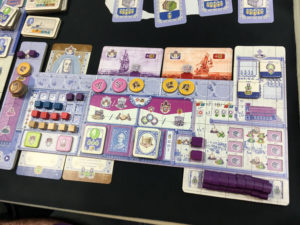 Sometimes the word “backdrop” is used to describe a game’s theme, especially with games that have only a minor connection to their theme. On other occasions, designers can take a theme and elevate it beyond the confines of the game. Vital Lacerda is a designer who knows this. When his new game was announced as covering the aftermath of the earthquake, fires, and flooding in 1755 of Lisbon, this reviewer took notice. Vital is the kind of designer to have an intimate connection with his subjects, and for a game to have his home town in the midst of tragedy as a theme, it screams of something special.
Sometimes the word “backdrop” is used to describe a game’s theme, especially with games that have only a minor connection to their theme. On other occasions, designers can take a theme and elevate it beyond the confines of the game. Vital Lacerda is a designer who knows this. When his new game was announced as covering the aftermath of the earthquake, fires, and flooding in 1755 of Lisbon, this reviewer took notice. Vital is the kind of designer to have an intimate connection with his subjects, and for a game to have his home town in the midst of tragedy as a theme, it screams of something special.
Following the disaster, Lisbon rebuilt using the rubble of the previous buildings. In Lisboa, players take the role of enterprising nobles in this venture. The game presents a card play, action selection, resource management, and city building experience for 2-4 players. It takes about 45 minutes per player.
Gameplay Overview:
Lisboa is an incredibly deep game. There are a lot of mechanisms at work and, as such, readers who need the most specific explanation of rules would behoove themselves to download a PDF of the rules. Here’s the gameplay in brief for the crowd short on time.
Each turn, players will be playing a single card from a hand of five. These come from stacks of four card types. Three card types represent Nobles who will help the players complete tasks rebuilding the city and the economy. The other card type represents special municipal events that will aid players.

When played to the main board, these card types require money or influence, the game’s primary two currencies. Cards played to the player’s player board represent investment in the player’s businesses and as such, grant player’s bonuses.
Additional resources come from goods (cloth, tools, books, and gold). Players can produce these at shops they build with money. As the city’s economy springs back to life; the value of these goods declines. Players can sell these goods using ships, which players can also build. However, if they choose, they can barter these goods with the Nobles to take some of the actions the Nobles normally offer.
Meanwhile, players will also be acquiring in-game bonuses: benefits granted by visiting the clergy. These are represented by small tiles collected on the player board. Additionally, end-game cards are necessary which will earn points for various objectives such as having the most stores on a certain street or most public buildings from a certain architect.
The main game actions are centered on the rebuilding activities. Two types of structures are erected on a grid plan of downtown Lisbon. Players can acquire points for majorities of buildings built on the various streets and also making sure their buildings are lined up with public offices constructed. These offices require that players have the appropriate architectural plans and have enough officials working in the government.
At the end of the game, players receive a variety of points from all these activities. They add up to determine a victor, the most prestigious noble in Lisboa.

Game Experience:
Before any discussion of gameplay, the work of artist Ian O’Toole should be mentioned. It is phenomenal. Without sounding like a paid mouthpiece for the publisher it is hard for this reviewer to state how exceptional all printed components are. The visual style lovingly follows the aesthetic of blue tiles that were popular in Lisbon at that time. The layout, functionality, and efficiency of the illustration and design are wonderful.
This extends into the game’s connection with theme. Vital Lacerda has done an amazing job here as well. Even if players never notice, the game’s cards include events that occurred in Lisbon that have a connection with the card’s action. There are even several mentions in the rules explaining events to shore up the purpose of various game actions. And even the layout of the board’s city building follows downtown Lisbon’s map.

Switching to gameplay, there is much to be excited for. Games bearing Vital’s name are known for being heavy affairs with interconnected mechanisms asking to be explored and dissected. This is true here as well. Benefits from one game element, especially from the Clergy Tiles, are a call to find combinations and utilizations with other actions within the game. It’s easy to get sucked into this world while making a grand plan for the end game.
At the heart of Lisboa is the one mechanism that seems to stand out. The card play to the main board or to a player’s own board comprises two very distinct types of actions. There some similarity in how overlap in outcomes with these mechanisms. If a player tucks a card into their player board, they still have the opportunity to complete some Noble actions by paying goods. This is similar to taking a Noble action by paying Influence with another card. In addition, players can also Sponsor Events to complete actions by playing another type of card and spending money. The short of it is that there are many ways to do the same thing.

Some of this is explained in the Player Aid, but even this wordy diagram of a turn structure doesn’t come off as simple or direct. Because of this, with every initial explanation of the game, players often need to be reminded how they can achieve something, more often a problem with Lisboa than other games of similar weight. Although this is minor compared to how much fun the choices are, it’s the one area which this reviewer continuously encounters as a negative.
Multiple plays, as mentioned above, alleviate this and unshackle a game of immense depth and challenge. Strategy and tactics demand attention with every turn. There’s real frustration when other players build a store in just the right location, blocking others. There’s extreme satisfaction at seeing objective cards revealed which boost a strategy already in play. And, there’s a real sense of never having mastered the puzzle, even after the end of a tight victory.
Final Thoughts:
Given the pitch for Lisboa, gamers might be inclined to look at it as just another city based Euro. This could not be further from the truth. Lisboa is an exceptional game. The execution of the idea is almost perfect, and that’s where the disappointment comes in. Players can rebuild the city time and time again, but there are a couple of mechanisms in Lisboa that beg to be more elegant. It’s an amazing achievement for a game designer to pull off such a design, but it also creates a high hurdle in terms of accessibility to a wider audience.
Final Score: 4.5 Stars – A tremendous achievement in strategy and connection with theme is just slightly marred by a steep learning curve.
 Hits:
Hits:
• Strategic and tactical decisions galore
• Amazing strong connection with theme
• Artistic decorative elements on all components
• Deep feeling of competitive tension
Misses:
• Unintuitive turn structure























Just going to echo Tahsin here and say Lisboa is fantastic and totally worth your time.
I don’t think the high learning curve is a matter of inelegance. I think the parts integrate in a way that is potentially not as intuitive as a game like Kanban or VInhos, where people understand how cars get build and how wine gets sold. Trying to design a theme around influencing nobles and the Church while rebuilding a city … is just a little more complicated place to start from.
But seeing it all come together more than makes up for it.